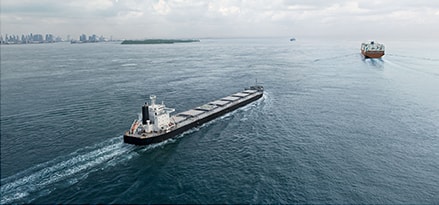Introduction
This technical topic helps explain ISO specification 8217 for Marine Fuel Oil RMG 380, which stipulates a maximum viscosity of 380 cSt. However, there is no minimum limit specified in 8217. In certain refinery configurations, residual fuel may be produced straight from atmospheric distillation instead of normal catalytic cracking streams. As a result, this marine fuel product is typically of a higher quality, but the viscosity may be significantly below 380 cSt. In these circumstances, the following guidance may be useful to users of the marine fuel products.
Fuel handling storage tanks
- When ordering bunkers, consideration should be given to the vessel fuel tank capacity, since with lower density comes higher volume for the same mass.
- Maintain the marine fuel product around 10 degrees Celsius above the pour point. This may require shutting down some or all coils of the vessel’s tank heating system.
- Employ the good bunker practice of not commingling different grades of marine fuel products. If unavoidable, as with any fuel product, carry out a compatibility test prior to commingling.
Settling tanks
- Maintain temperature for optimal settling conditions.
- If needed, tank heating should be shut down.
Purifiers
- Purifier parameters should be regularly monitored for proper operation.
- Follow original equipment manufacturer’s (OEM’s) advice to ensure purifier inlet temperature is correct for optimum separation.
Service tank
- Maintain service tank temperature to eliminate the possibility of system gassing, and to ensure proper viscosity for injection.
- Avoid unnecessary heating of the service tanks.
Calorific value
- The calorific value of straight run fuel is typically higher than the average cracked residual fuels by weight. Due to the reduced density, the calorific value by volume will be lower.
Viscosity
- Since the viscosity is reduced, the marine fuel products will require reduced heating. Consideration must be given to the fact that the actual operating temperature may be higher, further reducing the viscosity. Steam tracing may need to be shut off. OEM’s guidance on injection viscosity should be followed with regard to injection temperature monitoring.
Flash point
- No storage or handling issues ought to be anticipated. Typical flash point ought to be in the range of 70 to 80°C.
Other guidance
The following additional guidance is offered for boilers and steam plants.
Boilers
- For continuous operation on lower-viscosity marine fuel products, the air-fuel ratio may need to be adjusted for optimum combustion. Follow boiler’s OEM guidance.
Steam plants
- Consideration ought to be given where waste heat boilers are fitted to ensure sufficient dumping capacity in the steam plant.


